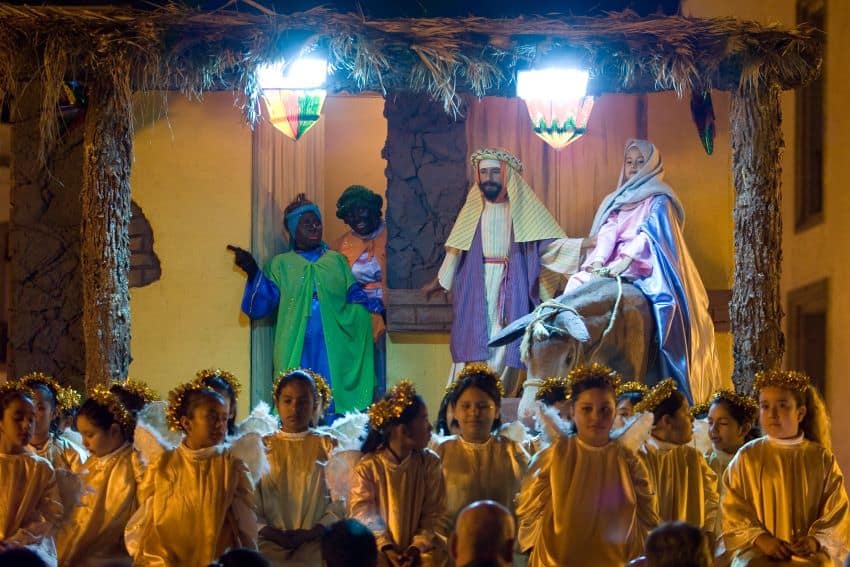The holiday season is here! Shops are filled with people buying sweets, fruit, tamales, and a variety of snacks. People scurry home, carrying traditional seven-pointed star piñatas. The air is scented with the smell of traditional foods being prepared. The sound of villancicos — Christmas carols — fills the air. Candles are getting hard to find. Alcohol can be even harder to find, especially outside of major cities.
The Christmas season lasts from December 12 to All Kings Day on January 6 (or for some Candlemas Day on February 2). During the Holiday season you can expect to see a mixture of pre-Hispanic rituals, religious ceremonies, and contemporary Christmas traditions such as Christmas trees and wreaths — a mix of Mexica, Catholic, and modern traditions typical of Mexico.

The Holiday season here works a little differently and goes on for much longer — so here’s a primer on what to expect
Christmas decorations
Before the Posadas begin, decorations will start going up. The main plaza in town is decorated with lights, Christmas trees, wreaths, and a large nativity scene. Families and neighborhoods will begin making “farolitos” to light the way for the posadas. Farolitos are paper lanterns made out of paper bags with designs cut into the face of the bag. The bags are filled with sand to hold them upright and a small battery-operated candle placed inside. It is said that lanterns lit the way for Mary and Joseph on their journey to Bethlehem.
Storage boxes are pulled out of closets containing the “Nacimiento” or nativity scene. Almost every house has one. The manger, figurines, and animals are carefully unwrapped and everything is displayed prominently as a reenactment of the birth of Jesus. For traditionalists the baby Jesus is not placed in the manger until Christmas Eve. The three kings inch closer to the manger each day until February 3rd, the day they arrived to present their gifts of gold, frankincense, and myrrh to the baby Jesus.
Mexican Christmas carols

Christmas songs are very popular in Mexico. They are a mix of traditional and contemporary, some of which you hear in the United States. “Noche de Paz” (Silent Night) is very popular. You will hear church choirs practicing this song for Christmas Mass. An indigenous couple comes down my street every Christmas, with the husband playing this song on his bugle while his wife collects tips from those who come to the door to listen.
A favorite song of the children is “Mi Burrito Sabanero,” a song about the little donkey that Mary and Joseph ride to Bethlehem, the birthplace of Jesus. A “villancico” (Spanish language carol) that nearly everyone has heard at least once is the fifty-year old “Feliz Navidad” sung by Jose Feliciano. A cheery, Christmassy song repeated endlessly in stores and bars leading up to Christmas to put you in the holiday spirit. For those who prefer more contemporary songs, there is Luis Miguel’s “Santa Claus Llego a La Ciudad,” performed with all the glitz and glamor of Frank Sinatra singing Santa Claus is Coming to Town.
Posadas
On December 16, the posadas begin. In a traditional posada, still enacted in many neighborhoods in Mexico, a procession of local participants will visit predetermined houses, sing, and ask for shelter. This is a symbolic recreation of the biblical story of Joseph and the Virgen Mary’s journey from Nazareth to Bethlehem. Led by Mary and Joseph, followed by angels, musicians and local participants. The group eventually all end up at a home that agrees to give them shelter. The procession enters the home and traditionally kneels before the altar and prays. After praying, the fiesta begins, complete with traditional food, drinks, pinatas, music, and ponche navideno. The posadas occur every evening for the nine days it took Mary and Joseph to reach the stable in Bethlehem on Christmas Eve.

Christmas Eve and Christmas Day
Mexicans eat their large family Christmas meal on Christmas Eve then everyone goes to midnight mass together. Christmas Day is for rest and leftovers or a smaller meal.
Why didn’t I get a Christmas Present?
If you stop by to wish a Mexican family “Feliz Navidad” on Christmas Day, you will notice there is no wrapping paper strewn about from unwrapping gifts. Christmas presents are not opened until Three King’s Day, January 3. On Three King’s Day, the kings have reached the stable to present their gifts to the newborn. In days past, it was traditional to shine up your shoes and leave them out the night before to be filled with gifts (similar to Christmas stockings), though this tradition has largely fallen by the wayside in modern Mexico.
On Three King’s Day, family and friends gather to open presents. After opening their gifts and sharing some holiday cheer they will each get a slice of the Rosca de Reyes — an oval or round Christmas cake – which has a small plastic baby Jesus hidden in one slice. The person who finds the baby Jesus must then throw a party for the others for Candlemas on February 2. Typically, this consists of tamales and atole, a pre-Hispanic drink made from corn, water, piloncillo, cinnamon, and vanilla.
If you are visiting Mexico for the holidays, be sure to go to a local marketplace and buy a Nacimiento and handmade ornaments to take home with you!
Sheryl Losser is a former public relations executive, researcher, writer and editor. She has been writing professionally for 35 years. She moved to Mazatlán in 2021 and works part-time doing freelance writing. She can be reached at AuthorSherylLosser@gmail.
